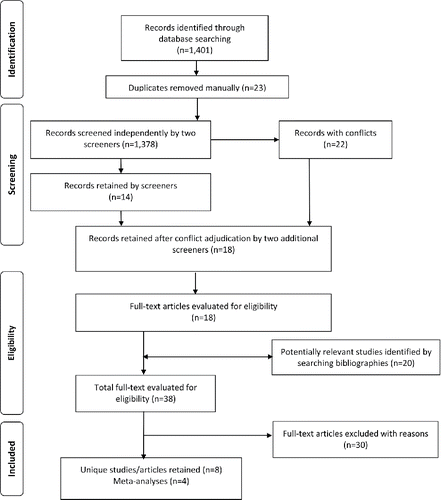Figures & data
Table 1. Synthesis of findings of the impact of caffeine as a countermeasure to mitigate fatigue, fatigue related risk, and or improve sleep for selected outcomes
Figure 2. Forest plots for Standardized Mean Difference between placebo and caffeine reaction time and lapses on the PVT test. a) Reaction time at end of shift. b) Reaction time change/delta from start-to-end of shift. c) Lapses at end of shift. d) Lapses change/delta from start-to-end of shift. Notes: report the standardized mean difference (SMD) for reaction time (a and b) and lapses (c and d) on the psychomotor vigilance test in participants receiving caffeine or placebo. The mean ± SD reaction time (ms) was calculated using data presented in each of the manuscripts and entered into RevMan to generate forest plots. All of the studies defined lapses as responses that were made after a specified amount of time had passed (500 ms – 5 seconds). The mean ± SD number of lapses were available for the 2 McLellan manuscripts, but only the mean number of lapses was available for the Kamimori et al. manuscript Citation(29, 30, 33). In order to estimate the SD for this measure, we used a conservative approach of doubling the mean, which was a significantly greater proportion of the mean than either of the other studies. In order to generate data, we relied on means and standard deviations/errors reported in each manuscript. We estimated the means and standard errors presented in graphs when means and standard deviations/errors were not reported. In all cases, we selected all time points after caffeine administration and averaged them across placebo and caffeine conditions. Data for PVT lapses were collected as follows: For the Kamimori et al. 2005 manuscript, data were found in Citation(33). Caffeine administration was indicated with dashed lines. All points after the first caffeine administration (305) were averaged up until time point 1100 hours for placebo and 200 mg of caffeine. The final time point was considered too long after caffeine administration, given a half-life of approximately 4.5 hours. For the McLellan, Kamimori, Voss, et al. 2005 paper, means and standard deviations were reported in the manuscript Citation(29). For the McLellan, Kamimori, Bell, et al., 2005 paper, data were extracted from Figure 4b from the referenced manuscript Citation(30). Caffeine was administered on Day 2 at 2130. We averaged the number of lapses for all time points on Day 3 for the placebo and caffeine conditions. We obtained PVT reaction time data as follows: For the Kamimori et al. 2015 manuscript, data were taken from and converted to reaction times Citation(31). We averaged data from all time points after the initial caffeine dose at 2100 hours, excluding the time points 1815 and 2100 on Days 3 and 4, as those were too long after the previous caffeine administration to be considered relevant. For the McLellan, Kamimori, Voss, et al. 2005 manuscript, data were taken from Figure 4 from the referenced manuscript Citation(29). We averaged all time points on Day 3 after the initial caffeine administration at 0140 hours for both placebo and caffeine. For the McLellan, Kamimori, Bell, et al. 2005 manuscript, data were extracted from Figure 4a from the referenced manuscript Citation(30). Caffeine was administered on Day 2 at 2130 hours. We averaged the reaction time for all time points on Day 3 for the placebo and caffeine conditions. For the Schweitzer et al. 2006 manuscript, data were taken from Figure 5 in the referenced manuscript and converted to reaction time Citation(32). We used the second time point, as the first time point on each night was prior to caffeine administration.


